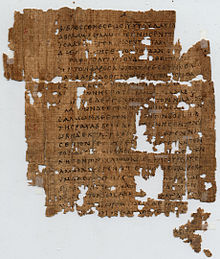Gospel of Matthew
![]()
This article discusses the Gospel of Matthew as a biblical book. For film adaptations, see The 1st Gospel - Matthew (Pasolini) and The Gospel of Matthew (van den Bergh).
The Gospel according to Matthew (or Gospel of Matthew, abbreviated: Mt) is the first of the four Gospels of the New Testament. The author does not give his name in the book. The title of the book and thus the author's name Matthew were added later. However, this happened at a very early date. Obviously the author is identified by this book title with a person who is mentioned in the book as a disciple of Jesus.
The Gospel of Matthew originates from a Jewish-Christian milieu in Syria, according to the majority opinion it was written around 80/90 AD and describes Jesus of Nazareth as the royal Messiah as well as the Son of God. In sharp demarcation against Jewish authorities (Pharisees) Matthew describes how Jesus turned to the people of Israel in a friendly and helpful way. Thus he fulfilled the words of the prophets of the Old Testament. The teachings of Jesus are unfolded in five great speeches, of which the Sermon on the Mount is the best known. Following Jesus becomes concrete for Matthew in righteous action. After Easter, Matthew's church saw itself commissioned to missionize people from all nations. They were incorporated into the ecclesia through baptism; the authority of Simon Peter guaranteed the authentic Jesus tradition. Very early the majority Gentile Christian mainstream church received the book and made it their main gospel.
Since the Gospels of Matthew, Mark, and Luke offer a similar account of the Jesus tradition (synopsis) that differs from the Gospel of John, these three writings are called the Synoptic Gospels.
The papyrus leaf 
Book title
The Greek title of the book is εὐαγγέλιον κατὰ Μαθθαῖον euangélion katà Matthaĩon, "Gospel according to Matthew." It is ancient, and is already presupposed by Papias of Hierapolis; thus the book was already known by this name about the year A.D. 100. The early church tradition (Papias' note and the Ebionite Gospel as earliest witnesses) designates Matthew the tax collector mentioned in the book (Mt 9:9 EU, Mt 10:3 EU) as the author. According to Ulrich Luz, exegesis has only a choice of explanations on this question, all of which are fraught with difficulties: That the book originally had a different title, or no title at all, is as unlikely as the assumption that the author was an otherwise unknown Christian named Mattaj - this Aramaic name is relatively rare. Nevertheless, according to Luz, the title of the book is younger than the book itself.
It is not exactly known how the gospels got their respective book title (inscriptio). The local Christian congregations probably already collected important writings in the 1st century, e.g. also the letters of Paul, and exchanged them among themselves. Martin Hengel assumes that individual congregations had their bookcase in which texts were kept that were intended to be read in worship, rather than for private reading. Probably, Hengel suggests, the titles were added by those scribes who made copies of the works for distribution to other congregations. It also happened that several gospels were combined into one codex. As recently as 2012, an endpaper with the title of the Gospel of Matthew was published as a fragment belonging to 
Early Church Tradition
Papias of Hierapolis reported about the author of the gospel with reference to an anonymous presbyter:
"Matthew therefore compiled in Hebrew the words (τὰ λόγια), but every one translated them as he was able."
- Eusebius of Caesarea: Ecclesiastical History 3,39,15
This information, preserved as an excerpt by Eusebius from the lost work of Papias, is at variance with the finding that the Gospel of Matthew is not only in Greek, but was composed in that language. "The style and use of language throughout the book are of a uniformity which a translator would never achieve." A Hebrew (or Aramaic) original version of transmission complexes cannot be proved. But the phrase Ἑβραΐδι διαλέκτῳ Hebraḯdi dialéktō need not necessarily be translated as "in Hebrew"; as Josef Kürzinger pointed out, this is not even philologically obvious. What Papias had meant was "in Jewish mode of presentation," namely, a certain way of disposing of the material. The early church authors had misunderstood Papias.
Search within the encyclopedia

_-_Gospel_of_Matthew's_title,_euangelion_kata_Maththaion.jpg)